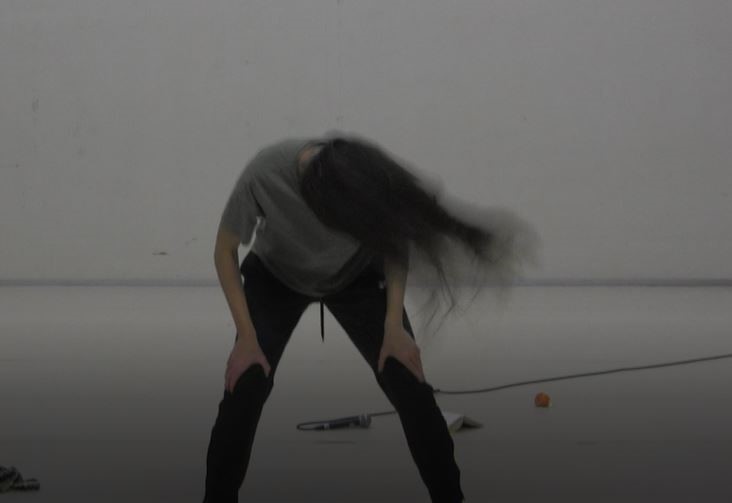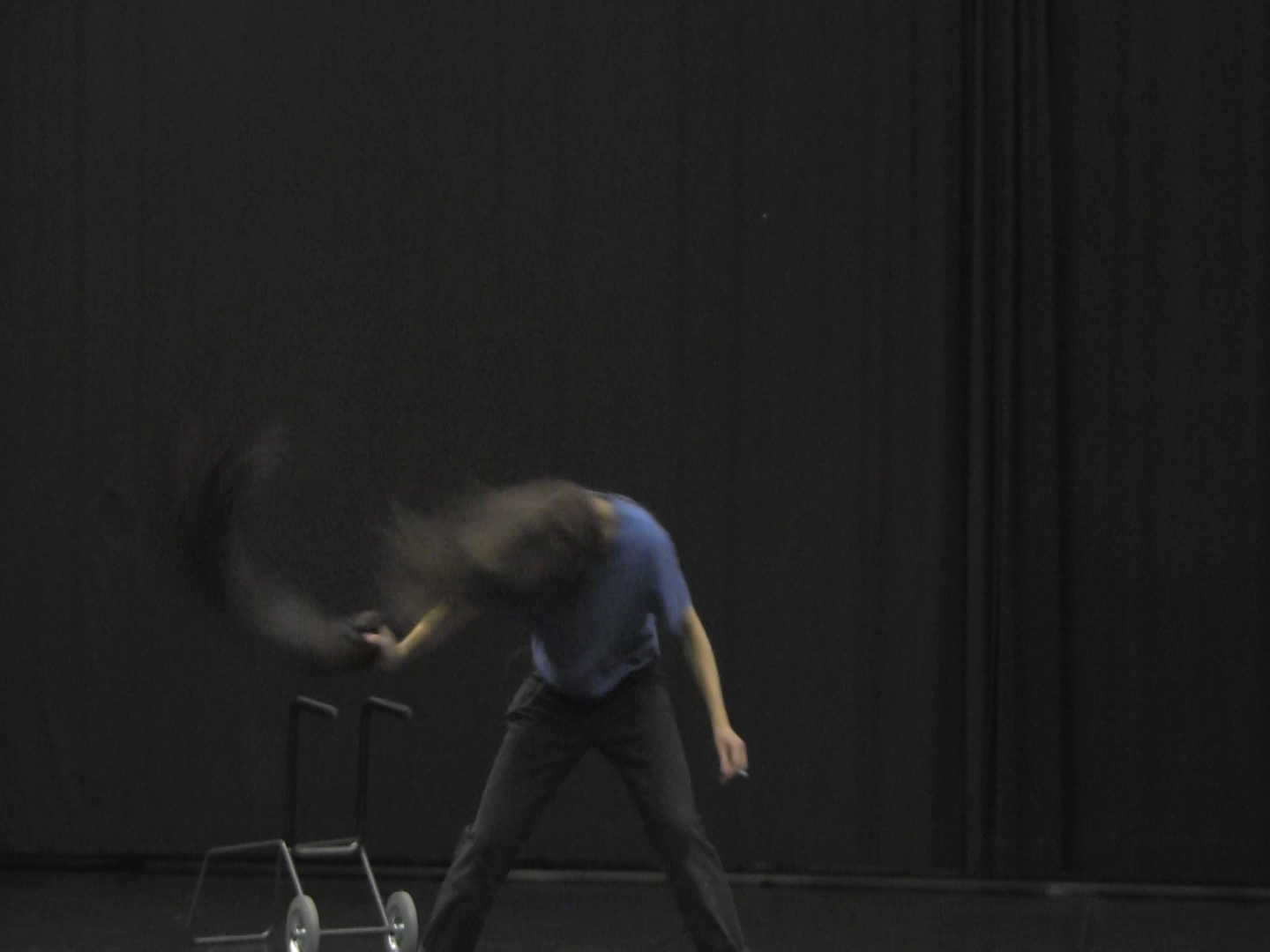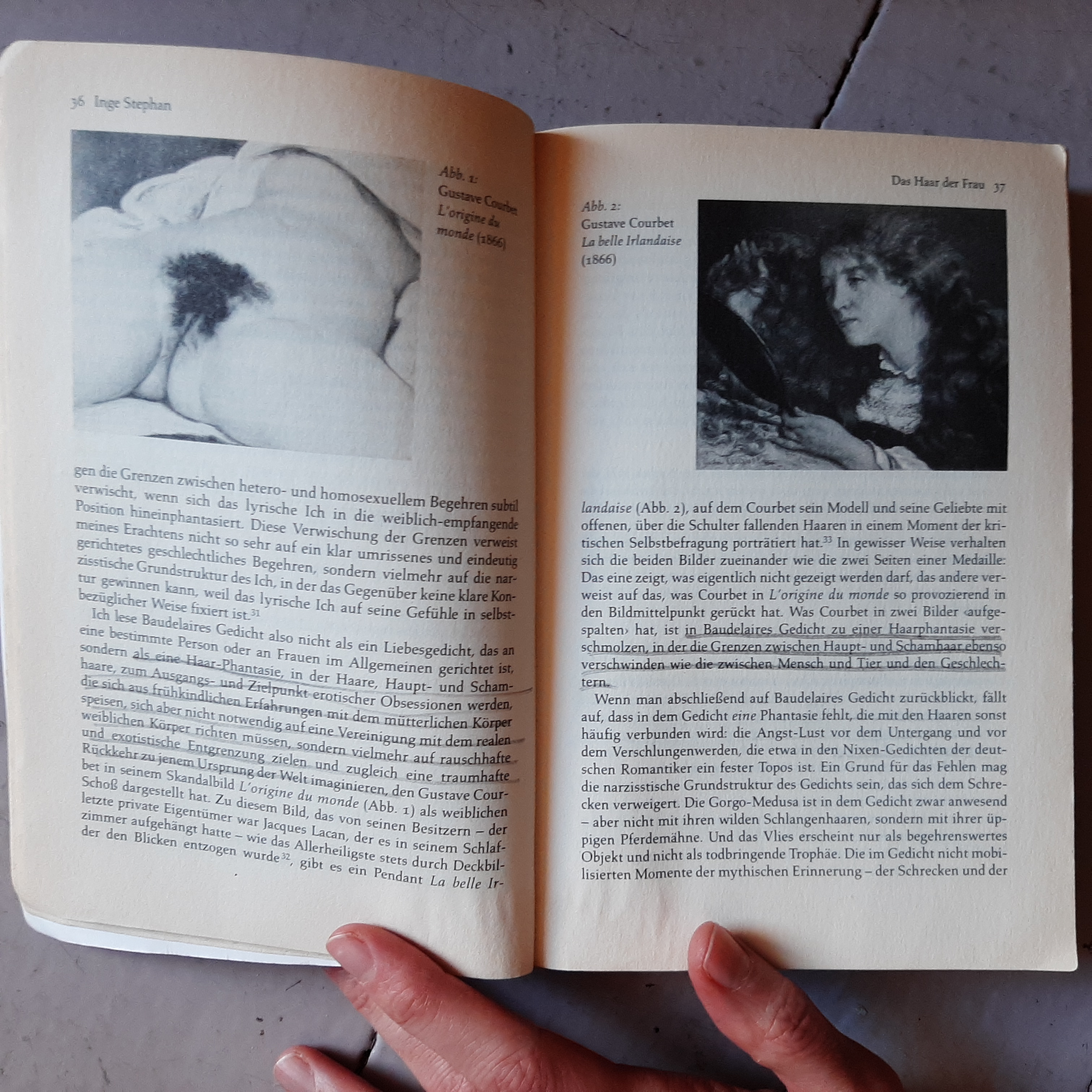FROM HEADBANGING TO HAIRBANGING

A SELF-INTERVIEW ON A RESEARCH PROCESS
How did you come up with practicing headbanging?
What does it mean to dance alone-together? How can a singular dancing body uphold a possibility of becoming plural? These were questions that I was exploring, just before urgent discourses around how to protect community, networks and solidarity in times of a radical global situation due to the pandemic appear. Apparently, while during the pandemic outbreak I decided to continue under the same thematic, realizing that dancing alone-together apart from becoming extremely urgent, it also opened up crucial questions about how do we perceive our bodies in relation to others and how do we imagine ourselves in relation to the word (and all that is considered living in general).
Researching around the role of the body in mass theory, I focused on the concept of the ‘discharge’. What caught my interest was the fact that discharge, is an action that comes after a state of waiting. It transforms a group of people who happen, for entirely accidental reasons, to be together, into something that finds some sort of communality. Following this, I focused my attention to the idea of discharge as a redeem of ‘anticipation’, of longing for something. For the philosopher and author of “Unworking Choreography:The notion of the work in Dance” Frederic Puillaude, gestures of discharge (as for exemple the applause of the audience after a performance) are the “delayed indication of a hope, in its ultimate and disappointed substitute.” So, coming back to your question, I used the action of headbanging as my case study and as a choreographic tool, with the wish to re-claim the hope in movements of discharge and explore aesthetic, political and social resonances from a dancer’s perspective.
Headbanging is commonly associated with music genres like heavy metal, rock , punk etc. as well as it has become common in various electronic dance music genres. What is your personal relation to these music cultures?
One can tell that headbanging has never been part of my movement vocabulary, as I have never considered myself being part of punk or heavy metal culture. However, I have been interested in exploring the cultural, and sociopolitical contexts with which an embodied collective practice is interacting. Headbanging apart from musicians on stage and fans of heavy metal music has been part of different cultures and traditions throughout history. It is part of Islamic devotional Sufi traditions, dating centuries back, as well as of the ascetic-dervishes dances in Iran. In mystical Sufi rituals, headbanging is used for remembrance and a meditative action for establishing a spiritual communion with God, while seeking enlightment while in Kurdistan Sufi men dancers are headbanging for protesting against the unlawful imprisonment of Iranian citizens who took part in anti-government demonstrations.
Video YouTube Headbanging Sufis:
Video Sufis in Headbang Session:
In accordance to this, practicing headbanging creates for me a connotation of a community by default. It is a gesture of embodied ‘discharge’ of different type of crowds, which also has specific gendered connotations. It works on the precondition that it is connected with specific events and thus stabilized itself in a context of ‘collective memory’. I have been practicing headbanging with an intention to put up in negotiation any perception of stability concerning approached of collective identity.

What does headbanging mean to you then?
Ιn first place, headbanging has been for me an action with which the beat of the music was emphasized. I’d say it was like tapping the foot on the ground or like practicing the what I call: ‘body-metronome’.
Moving deeper in the research, headbanging became for me a movement that relocates relationships in time and make events slip across years. It is a point of recognition, a memory, personal and cultural. And in that sense it constitutes an endless chain of reciprocity and exchange of time, affects, sweat, breathing, historical, cultural and political particles between bodies, which is never ever static. Instead, it is always in a turbulent moving.
In your work there is a strong interest for isolating and ‘individualizing’ dances and movements that are meant to have a social aspect. Is your intention to invert the public and social dimension that such dances propose?
Indeed, headbanging acts for me as a cultural storage system, a moving archive of trends and aesthetic preferences but also cultural and historical contexts. But what is important for me in the ‘social dimension’ of it, is that it is developed and put to use by people who dance it. The same happens with popular and social dances, like for exemple traditional, folk or urban dances.
In that sense, I explore collective resonances on the gesture per se, while experiencing a by default contrast when isolating the ‘social’ context that such a practice proposes and exploring it though a solo body. And significantly there is an interest in that approach which position my research in discourses about bodies in relation, coexisting, and being together, starting from the idea that the experience of togetherness is situated to an act of imagining.Trying to find ways to performatively connotate other bodies while moving, upholds for me the possibility of an imaginative engagement . And this is where the potentiality of being together starts to emerge.

Headbanging is an action focused mainly on the motion of the head. What does it mean for you that isolation of this specific body part?
At first glance, a sense of self is associated with the head. Throughout the history, the “I” (head) and “my body” (the rest of my body) existed as identifiably separate, partially because of vision’s extreme precision in coordinating with locomotion to navigate the word and partially because of one’s ability to see many other parts of one’s own body. (Choreographing Empathy: Kinesthesia in Performance, Susan L.Foster, Routledge, 2011).
Notably this argument goes against the concept of kinesthesia about understanding movement through other sensations in moving bodies. But for me it is interesting how under the perspective of the head, headbanging proposes a quality of disorientation, of dizziness.
This comes obviously forward, when I am practicing it. After 15 minutes for example of headbanging, I start feel unsteady. Dizziness creates this sense of spinning, of vertigo and thus destabilization. And this experience of “disorder of things” is something that I relate to a reformulation of relations and hierarchies, space-wise, perceptively wise but also a reconsideration of stability, rigidity, and thus a disobedience to universalistic regimes of perception, objectivized regularities and even stable historical scripts. For me the experience of dizziness makes things fragile, vulnerable and in that sense open to negotiations, hesitations, doubts and reformulations, revealing vague spaces of potentiality to appear.
Were there unexpected associations that appeared throughout your research process?

Something that manifested itself uncontrollably and very clearly throughout headgbanging was the structure/the idea/ the texture of the hair. That’s when I reformulated headbanging to ‘HAIRBANGING’ and started researching on the idea of the ‘hair’ in different contexts:
I started reading about ‘long hair throughout human history’, and looked closely to the history of hair in dance. So for example in 1800s, pulled-back hair was a sign of formality and respect. Ballet mirrored this formal society in its portrayal of feminine beauty. (How would a ballerina headbang?) Then Isadora Duncan in the early 1900s, came to stage barefoot, with her hair flowing. And more recently in the gendered tendency of female bodies of Pina Bausch or Anna Teresa de Keersmaeker, who are often represented with long hair freely moving back and forward, claiming their personal freedom as sensual beings.
This aspect of gendered representation has become central while practicing hair-banging. And questions over feminism and femininity (women independence in 19th century women liberation in the 30’s), the emancipation of women and female sensuality were coming into surface. And still, in the visual representational realm, hair-banging proposed a kind of identity transformation which through repetition manifests itself through a constant shift.
Another aspect that appeared was how hair-banging started to interplay with the fetishization of hair. Questions over the way popular culture addresses the marketing of hair through advertising campaigns, the language of hair and the material qualities of traits such as “shine”, “bounce” and “swish” in selling European hair- and hair products. And other connotations like: Hairography in drag performance or the hair as the reminiscence of the dead body.
